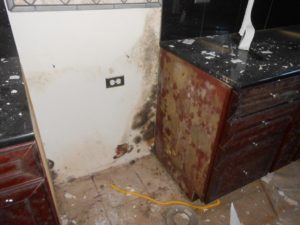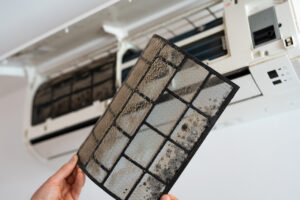 With mold, it isn’t always as simple as “what you see is what you get.”
With mold, it isn’t always as simple as “what you see is what you get.”
Mold can cause discoloration of your walls, but it’s not always the same color. It can be black, but that doesn’t mean it’s the “toxic black mold” you’ve seen in the news.
If you aren’t well-versed on all things mold (and why would you be?), identifying it probably isn’t one of your super powers.
That’s why you have us!
Signs of Household Mold
Some mold can cause discoloration on your walls. It can show up as green or gray or black. It also gives off a slight musty smell.
If you notice these two things inside your home, it doesn’t mean it’s time to put your house on the market and run for the hills. But it’s not a bad idea to get it checked out.
This is because all mold has varying effects (some cause respiratory issues while others can cause rashes and itchy skin) and can even begin to affect the structure of the building.
Mold likes to feed on many things ranging from wood to your curtains to carpet and even your clothes, so it’s important to get a plan in place in order to get it out of your house.
This is why it’s important to know which type of mold you have residing in your humble abode and what your plan of attack is going to be for the long term.
Toxic black mold can release spores as it feeds on common household materials such as drywall, carpet, insulation, or sub-flooring that have been exposed to moisture.
Toxic Black Mold vs. Mold That is Black in Color
Toxic black mold, or Stachybotrys chartarum, is the most notorious type of mold and isn’t all that picky when it comes to its eating habits. It can see a buffet in anything from your carpet to your drywall to your insulation; and because all of these things are found in most homes, toxic black mold is commonly found growing in homes all across America.
This mold, unfortunately, also creates a bevy of health issues in both humans and pets.
Chronic coughing, sneezing, itchy watery eyes, and runny noses are all side effects of black mold exposure, but even the non-toxic mold types can have a range of these symptoms. When you have professionals come in to check out the situation, they can give you an answer on what type of mold you’re dealing with and what you need to do to resolve the issue.
Time for the Professionals
If professionals do determine you have any kind of mold in your home, removal will be needed.
This is the part where most people panic and I say, “Whoa there, partner.”
While long-term exposure has, in some cases, shown to cause more serious side effects, this doesn’t mean you need to rush your decision on your removal plan. It doesn’t even mean you need to pack everything up and get the kids to grandma’s house.
With mold, the key phrase is “long-term exposure.” I don’t want to sound flippant because toxic black mold can be a serious health concern for some, but it’s OK if you take your time and talk to some people in the industry to know what your plan needs to be and what is involved.
Household mold removal can be costly so it’s something you want to get right the first time. At Mold Solutions, we like for our customers to have the peace of mind in knowing we’ll solve their mold issues.
If you have any questions or concerns, or just want to talk through the suspicion you might have mold, we’d love to hear from you. We have a team of trusted and certified professionals ready to help every step of the way. Contact us today!







